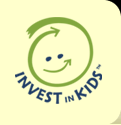Intellectual Development means being able to communicate, to think both creatively and abstractly, to pay attention, solve problems, and develop keen judgment and a lifelong readiness to learn. | Emerging Skills Begin to sort and classify objects by characteristicsCompare amountsBegin to understand and apply concepts of pattern, sequence and orderBegin to understand concepts such as oppositesBetter understand and recognize different shapesBegin to understand directional and positional concepts (how objects are positioned in space, for example, over, behind, next to, etc.)Find out more about What to Expect from your preschooler, 3 to 4 Years. |
|
Parents Can: Introduce the concepts of sorting and classifying in daily routines. For example, "Let's put your socks in this drawer and your shirts in this drawer" or sorting groceries by fresh fruits, cans, boxes | Child Will: Begin to understand that any group of items can be sorted into setsBegin to understand that he can create any "set" he wishes
| |
Parents Can: Talk to their preschooler about events or people that make him feel happy, sad or angry | Child Will: Begin to classify common events and objects in his life, such as things that make him happy or sad, things that are fun and things that are scaryBegin to categorize and sort the emotions and responses of others in his environmentGain awareness of his own feelingsBecome comfortable with talking about emotions
|
| | |
Parents Can: Provide their preschooler with a box of mixed beads or buttons that can be sorted by colour, shape, number of holes in a button and so on, in an egg carton | Child Will: Will sort and classify by different characteristicsBegin to create her own classification systemBetter understand and recognize different shapes
| |
Parents Can: Provide hard and soft craft materials such as feathers, cotton balls, strings, popsicle sticks and beads. Have their preschooler create a picture and talk about the different textures and why some are soft and others are hard | Child Will: Begin to understand the concept of oppositesUnderstand another way materials can be classified
| |
Parents Can: Engage their preschooler in matching games using cards or home made sticker cards | Child Will: Practice matching paired cards (for example, fruits, colours, shapes)Strengthen memory skills as she tries to find a matching pair from cards that are turned over (more advanced skill)
|
| | |
Parents Can: Use play with peg boards, lego, blocks and other building materials to explore different patterns, shapes and sequences | Child Will: Begin to recognize patternsBegin to recognize and label shapes and coloursExperiment with pattern makingBegin to understand how sequences make up patterns
| |
Parents Can: Include their preschooler in cooking activities, and use these to explore measurement | Child Will: Learn about different quantitiesExplore different textures in wet and dry ingredientsUnderstand how quantity, numbers and measurement all relate
|
| |
|
